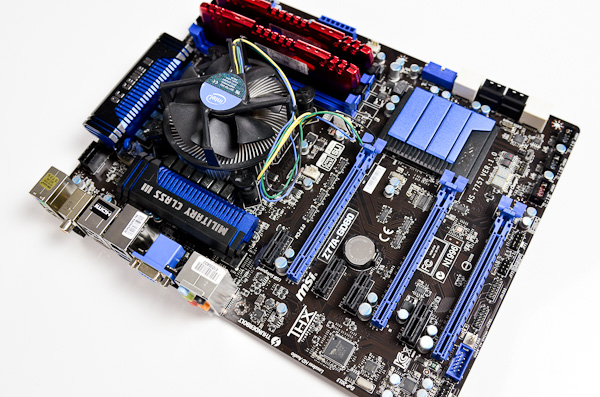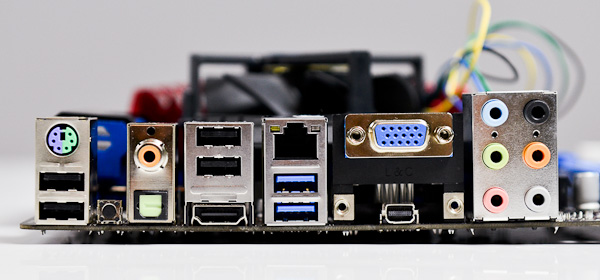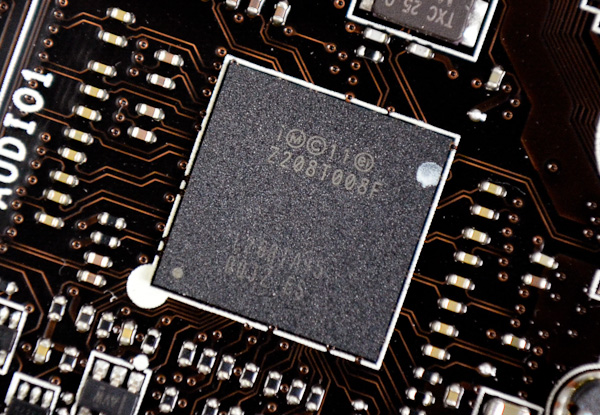A First Look at Thunderbolt on Windows with MSI's Z77A-GD80
by Anand Lal Shimpi on May 11, 2012 1:32 PM EST- Posted in
- Motherboards
- CPUs
- Intel
- MSI
- Thunderbolt
Update: Intel has informed us that we will see updated drivers for Windows certified Thunderbolt devices that will enable hot plugging under Windows as well as address some of the behavior we've seen. Intel further informed us that MSI's board has not yet made it through the certification process and a lot of these teething issues will hopefully be addressed by then.
I finally made the transition to a notebook as my desktop last year, a move many had made years prior. Quad-core mobile Sandy Bridge and good SSDs made the move simple for me, but Thunderbolt eventually made it near perfect. With only two drive bays in my notebook (I ditched my optical drive so I could have another SSD, something Brian Klug did back in 2010), there wasn't any room for good, high-performance, mass storage. Thunderbolt solved this problem for me.
Co-developed by Apple and Intel, Thunderbolt is a tunnel that carries both PCIe and DisplayPort traffic to the tune of 20Gbps per channel (10Gbps up and down). In the past, whenever you wanted to add a PCIe device (LAN, audio, high-speed storage, etc...) you needed to physically install that device in your system either via an ExpressCard slot on a notebook or via a PCIe slot on your desktop. Thunderbolt acts as a decoupler for PCIe devices, allowing you to put controllers that would traditionally lie inside your system outside of it, or even inside another device like a display. That's where the DisplayPort support comes in.
Apple's Thunderbolt Display is the perfect example of what Thunderbolt can be used to do. Take a DisplayPort panel, integrate Gigabit Ethernet, Firewire 800, audio and USB controllers and you've got Apple's Thunderbolt Display. In theory, you could connect a system that had none of these things, and the functionality would be provided exclusively by the display. Decoupling hardware like this allows OEMs to build thinner and/or smaller form factor machines (think Ultrabooks/MacBook Air), while allowing for full functionality when connected to a display. By carrying DisplayPort over the same cable, you can have a single cable that both extends functionality and connects your small form factor machine to a larger monitor. Thunderbolt enables the modern day dock for notebooks.
For all of last year, Thunderbolt was an Apple exclusive. This year, starting with the launch of Ivy Bridge, Thunderbolt is coming to PCs. We'll see it on notebooks as well as some desktop motherboards. Today we have the very first desktop motherboard with Thunderbolt support: MSI's Z77A-GD80.
Don't expect ubiquitous deployment of Thunderbolt, especially not on desktops, as the Thunderbolt controller and associated components add cost where margins are already very thin. Instead you can expect higher end motherboards to integrate it, or offer an add-in card of sorts which is the route ASUS is taking. I'd expect Ultrabooks to make better use of Thunderbolt naturally, but we will see it on desktops this year.
The Z77A-GD80 is a very full featured ATX Z77 motherboard. You get three physical PCIe x16 slots, although they are only supported in the following configurations:
| MSI Z77A-GD80 PCIe x16 Supported Configurations | ||||
| Ivy Bridge | Sandy Bridge | |||
| PCIe x16/0/0 | 1 x16 | 1 x16 | ||
| PCIe x8/8/0 | 2 x8 | 2 x8 | ||
| PCIe x8/4/4 | 1 x8 + 2 x4 | Not Supported | ||
Both CrossFire and SLI are supported.
You'll find a standard eight SATA ports on the motherboard (4 x 6Gbps, 4 x 3Gbps, 6 driven by Intel's controller). USB 3.0 comes native thanks to Intel's Z77 chipset, with two ports on the rear IO panel as well as a header and a supplied bracket for two more ports. Intel LAN comes standard as well. Audio is driven by a Realtek ALC898 controller, while VIA's VT6315N powers the on-board Firewire header.
The Star of the Show: Thunderbolt
The big news is of course the Thunderbolt port on the IO panel. Counting it, there are a total of three display outputs on the GD80, the other two are VGA and HDMI.
I believe the Thunderbolt controller on the GD80 is this little chip on the board, just behind the analog audio outputs on the IO panel. It also looks like the controller branches off of the Z77 PCH's PCIe 2.0 lanes. Although there are four PCIe x1 slots on the board, you can only use two at a time - likely because of the way the Thunderbolt controller connects to the system as it uses 4 of the 8 available PCIe 2.0 lanes. The remaining lanes aren't enough to support the on-board LAN, Firewire, audio and SATA controllers in addition to the extra PCIe slots and Thunderbolt. As a result there are limitations on what you can use in parallel (e.g. you can't use Firewire and SATA ports 7/8) in order to deal with the PCIe overprovisioning.
The markings on the Thunderbolt controller aren't familiar, so it could very well be that we're looking at Cactus Ridge - Intel's 2012 Thunderbolt controller we first heard about last year. Cactus Ridge doesn't change performance, it just helps reduce cost by integrating more functionality into the controller itself.
The beauty of Thunderbolt is it's near invisible to the OS. You don't need to install any drivers to take advantage of it, just plug your devices in and as long as your devices have driver support they'll just appear. The OS has no idea that your SATA, Ethernet or RAID controllers are sitting a few feet outside of your box, they all appear as normal PCIe devices.
As we found in our initial review of Thunderbolt on the MacBook Pro, Windows does not allow for the hot plugging of Thunderbolt devices. You can remove a Thunderbolt device once in Windows, but you cannot add a new one. Anything you want access to in Windows has to be plugged in at boot. OS X allows more flexibility in this regard as you can add/remove Thunderbolt storage and other devices while the OS is running, but even then it's not always well behaved. It's not all that uncommon to need a reboot after plugging in a chain of Thunderbolt devices under OS X, although admittedly Apple has been improving compatibility and behavior over time.
Update: Intel has informed us that we will see updated drivers for Windows certified Thunderbolt devices that will enable hot plugging under Windows. Intel further informed us that MSI's board has not yet made it through the certification process and a lot of these teething issues will hopefully be addressed by then.






















98 Comments
View All Comments
ananduser - Friday, May 11, 2012 - link
I recall MS stating that TB will never be supported by them due to security issues. TB support will have to be provided by 3rd parties.A5 - Friday, May 11, 2012 - link
And the article pretty clearly states that TB is transparent to the OS because it is just a bunch of PCIe lanes. MS doesn't really need to do anything to enhance support.embeddedbill - Friday, May 11, 2012 - link
The security issues have nothing to do with 3rd party support. Pcie in every other instance was an internal device, now via TB, someone can develop a piece of hardware that has nefarious firmware and gain system level access - without opening up the computer.DerPuppy - Saturday, May 12, 2012 - link
pretty much: see firewire. direct memory access "issues" i guess. but if someone has physical access to your computer you're screwed anyways.ka_ - Friday, June 1, 2012 - link
"pretty much: see firewire. direct memory access "issues" i guess. but if someone has physical access to your computer you're screwed anyways. "I must say I disagree to this to a large extent even though I would agree if we add: Physical access without anyone else present.
It is something entirely different to require someone to force power offs, use screw drivers, or do some other highly unusual things to a machine than simply plug it to a display or NAS or something with two tb connectors and hack it from the machine connected on the other side. That or a device with chained TB connectors i.e. projector sharing the connection with a Trojan device.
Expect to see something like this on a security conference soon... "We tested this projector on all the presenters machines and..."
embeddedbill - Friday, May 11, 2012 - link
Microsoft will also have an aversion to anything that allows you to boot using Windows on an external disk. Pcie is a threat to that because they might feel some loss of control.dagamer34 - Saturday, May 12, 2012 - link
Em... Windows 8 To Go allows you to boot a full version of Windows from a USB stick.Conficio - Friday, May 11, 2012 - link
And why again would I pay top dollars (for the mother board, the peripheral and the cables to connect those) to put the storage outside of my full size desktop? I don't see the use case.If it would be a nice small form factor running silently and still is expandable through thunderbolt, that would make sense.
Or if I can access the storage and the display in my desktop through thunderbold from my laptop (and auto backup/sync/drop box) that would make sense as well. The standby desktop becoming the hub, sounds feasible to me as the interface is symmetrical.
By the way w/o hot plugging this is broken. As you report those issue on Mac OS X as well, I'll go and wait until this becomes stable.
embeddedbill - Friday, May 11, 2012 - link
The most compelling use cases will be in the mobile market for sure. However for someone who covets the bandwidth for frivolous stuff, I can see this in a niche.ggathagan - Friday, May 11, 2012 - link
Given the ability to daisy chain up to six devices, this could represent an awful lot of storage capacity.From the manufacturer's standpoint, I think it makes a lot of sense for MSI to use ATX for their 1st motherboard with TB.
ATX has lot more real estate to work with when deciding how to design the motherboard.
It's also their flagship Z77 motherboard, with all the bells-and-whistles.
At the price point of their flagship board, it helps recoup R&D costs.
Given the scarcity of TB devices at this point in time, I doubt anyone wants to dive in.
I expect more of a "sticking-my-toes-in-the-water approach from board makers.
Once there are more devices made to utilize TB, I think you'll see a more widespread adoption of TB.
As others have pointed out, TB has a better fit in the mobile market at this point.